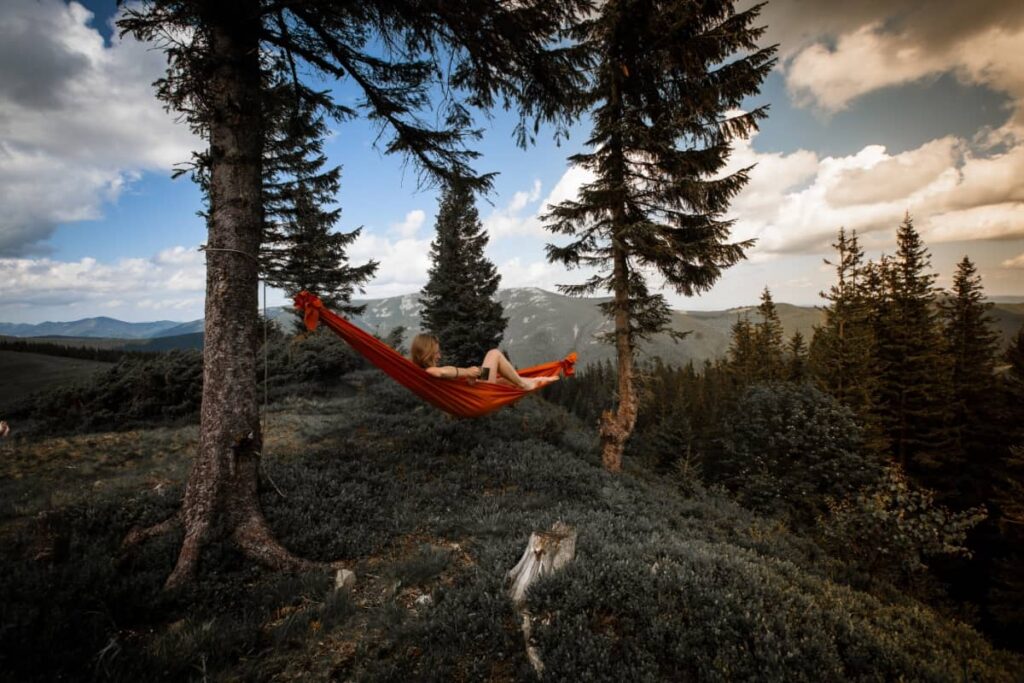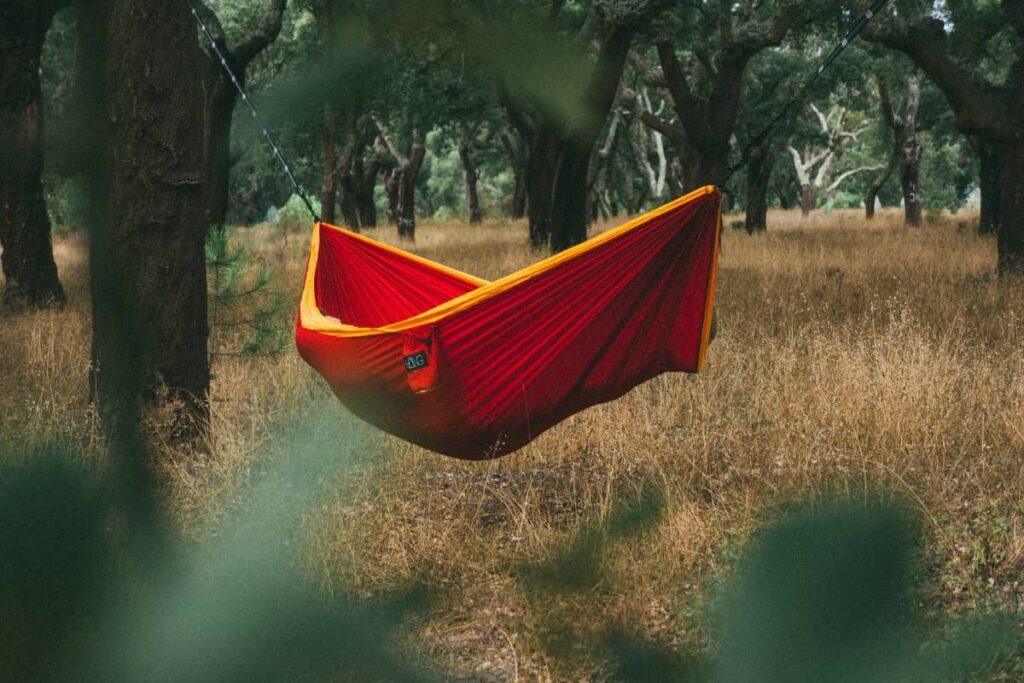Hammock camping is a lightweight, comfortable alternative to traditional tent camping where you sleep suspended between two trees or anchor points. As more outdoor enthusiasts discover the freedom of sleeping elevated off the ground, hammock camping has grown from a niche activity to a mainstream camping option.

What You’ll Learn in This Guide
In this comprehensive hammock camping basics guide, you’ll discover:
- Why hammock camping might be perfect for your next outdoor adventure
- Essential gear needed for a comfortable hammock camping experience
- Step-by-step setup instructions for beginners
- Seasonal adaptations to stay comfortable year-round
- Expert tips to avoid common beginner mistakes
- How to enhance your hammock camping skills as you gain experience
According to the Outdoor Industry Association’s 2023 Outdoor Participation Report, hammock camping has seen a 30% increase in participation over the past five years, with beginners making up nearly half of new hammock campers.
Hammock Camping for Complete Beginners
If you’ve never slept in a hammock before, don’t worry! Hammock camping is actually one of the most beginner-friendly ways to enjoy the outdoors. The learning curve is gentle, setup is straightforward, and the comfort can far exceed that of sleeping on the ground.
Essential Hammock Camping Checklist for Beginners
Before heading out on your first hammock camping adventure, ensure you have:
☑️ Hammock – Choose a camping-specific hammock (not a backyard leisure hammock)
☑️ Suspension system – Tree straps and carabiners
☑️ Weather protection – A rainfly or tarp
☑️ Insulation – An underquilt or sleeping pad
☑️ Bug protection – Either a built-in bug net or separate bug net
☑️ Sleeping bag or top quilt – Appropriate for the expected temperature
☑️ Small stuff sack – To store items like your phone, headlamp, and other essentials
For beginners, an all-in-one hammock camping system might be worth the investment. These systems include the hammock, bug net, and often an integrated rainfly—greatly simplifying your first setup experience.
First-Timer Setup Tips

Your first hammock setup should be practiced at home or in a local park before heading into the backcountry. This allows you to:
- Learn the knots and adjustments without pressure
- Test your comfort and make adjustments
- Ensure all components work together properly
- Develop confidence in your system before depending on it overnight
Why Hammock Camp?
Benefits of Hammock Camping There are numerous advantages to hammock camping, including increased comfort, versatility, and a smaller environmental impact. Hammocks are particularly great for those who experience discomfort when sleeping on the ground, as they provide a more comfortable and customizable sleep experience. They also offer more flexibility when it comes to choosing your campsite, as all you need are two well-spaced trees. See also 10 camping hacks for a stress free camping experience.
Comparing Hammock Camping to Tent Camping
When compared to traditional tent camping, hammock camping has some distinct advantages. Hammocks are often lighter and more compact than tents, making them a popular choice for backpackers and minimalist or wild campers. Additionally, hammocks tend to be quicker and easier to set up, allowing you to spend more time enjoying nature.
Choosing the Right Hammock
Types of Hammocks
There are several types of hammocks to choose from, including gathered-end, bridge, and spreader-bar hammocks. Gathered-end hammocks are the most common and versatile, making them an excellent choice for beginners. Bridge hammocks have a flatter sleeping surface, which some campers find more comfortable. Finally, spreader-bar hammocks have a wider, flatter surface, but can be less stable.
Hammock Accessories and Features
When selecting a hammock, consider additional features such as built-in bug nets, integrated ridgelines, and pockets for storage. It’s also essential to consider the weight capacity and materials used, as these factors can impact comfort and durability.
Setting Up Your Hammock
Selecting the Perfect Location
Choosing the right location for your hammock is crucial. Look for two sturdy trees spaced about 12 to 15 feet apart. Avoid dead or diseased trees, as they can pose a safety risk. Make sure there are no hazards, such as sharp rocks or debris, beneath your chosen spot.
Hanging Your Hammock
The 30-Degree Rule
To ensure a comfortable and safe hammock hang, aim for a 30-degree angle between the tree and your suspension straps. This angle helps distribute your weight evenly and reduces stress on the hammock and trees.
Tree Straps and Carabiners
Using tree straps and carabiners makes hanging your hammock quick and easy while protecting the trees from damage. Wrap the tree straps around the trees, then attach your hammock to the straps using carabiners. Adjust the height and tension to achieve the desired 30-degree angle.
I highly recommend MalloMe XL Hammock Straps. Each strap is 12 feet long and 1 inch wide (to prevent tree damage). These straps are made with no-stretch, heavy duty triple stitched seams. They also come with 2 lock carabiners and a handy storage bag to keep your camp kit clean and organized. $18 at the time of publication.
Hammock Camping Through the Seasons
One of the biggest advantages of hammock camping is its adaptability to different weather conditions with the right gear and knowledge.
Summer Hammock Camping (60°F+ / 15°C+)
During warm summer months, hammock camping is at its simplest:
- Insulation Needs: Minimal – a light sleeping pad or underquilt is often sufficient
- Key Gear: Bug protection becomes your top priority
- Setup Tips:
- Configure your tarp in “porch mode” (raised on one side) for stargazing with quick rain protection
- Focus on finding shade for daytime naps
- Bring a small battery-powered fan for hot nights
- Temperature Rating: Look for hammock quilts rated 40-50°F (4-10°C)
Spring and Fall Hammock Camping (40-60°F / 4-15°C)
Shoulder seasons require more attention to insulation and weather protection:
- Insulation Needs: Moderate – a full-length underquilt becomes essential
- Key Gear: A quality tarp with excellent coverage
- Setup Tips:
- Pitch your tarp lower and tighter to block wind
- Use an underquilt protector to prevent heat loss from wind
- Pack layers that can be added or removed as temperatures fluctuate
- Temperature Rating: Look for hammock quilts rated 20-40°F (-6 to 4°C)
Winter Hammock Camping (Below 40°F / Below 4°C)
Winter hammock camping can be remarkably comfortable with proper preparation:
- Insulation Needs: Maximum – full winter underquilt and top quilt system
- Key Gear: Four-season tarp, underquilt protector, and possibly a “sock” or full hammock enclosure
- Setup Tips:
- Create a “winter sock” by fully enclosing your hammock with your tarp
- Consider adding reflective material under your hammock to reflect heat
- Keep water bottles in your hammock to prevent freezing
- Temperature Rating: Look for hammock quilts rated 0-20°F (-17 to -6°C) or lower
Temperature Management Tips
Remember that in a hammock, your greatest heat loss comes from below, not above. While a 20°F sleeping bag might be sufficient in a tent at 20°F, in a hammock you’ll need equivalent underquilt protection for the same comfort level.
Staying Comfortable
Insulation and Warmth
Sleeping Pads and Underquilts
Hammock camping in colder weather requires insulation to stay warm. Sleeping pads can be placed directly in the hammock, while underquilts are designed to hang beneath it. Both options provide a barrier against the cold air, ensuring a comfortable night’s sleep.
Bug Protection
Bug Nets
A bug net is essential for keeping insects at bay while hammock camping. Some hammocks come with built-in bug nets, or you can purchase a separate net that encloses the entire hammock.
Weather Protection
Rain Fly and Tarp Setup
A rain fly or tarp is necessary for protecting your hammock from rain and wind. Set up the tarp above your hammock, ensuring it is large enough to cover the entire hammock and angled to prevent water from pooling. Use guylines and stakes to secure the tarp.
Hammock Camping Etiquette
When hammock camping, it’s essential to follow Leave No Trace principles. This includes selecting appropriate trees, using tree-friendly straps, and packing out all trash. Be respectful of nature and other campers by keeping noise levels down and leaving your campsite in better condition than you found it.
Safety Considerations
Always inspect your hammock and suspension system for signs of wear or damage before each trip. Ensure the trees you choose are strong enough to support your weight, and avoid hanging your hammock too high off the ground. Keep a first-aid kit handy and be aware of your surroundings.
Tips and Tricks
Use a ridgeline to maintain the perfect hang angle and provide a place to attach gear, such as a headlamp or storage pouch. Keep your gear organized and off the ground with a gear sling suspended beneath your hammock. To avoid cold spots, consider using a double-layered hammock with a pocket for your sleeping pad. Try a “pillow pocket” or small camping pillow to keep your head comfortable and in place during the night. Practice setting up and taking down your hammock system at home before heading out on your first trip.
Frequently Asked Questions About Hammock Camping Basics
What are the absolute essentials for beginner hammock camping?
At minimum, you need a camping hammock, tree straps, carabiners, and a rainfly. For comfort in most conditions, add an underquilt or sleeping pad and bug protection. This basic setup covers the core hammock camping essentials that every beginner needs.
How much does a basic hammock camping setup cost?
Entry-level hammock camping setups start around $100-150 for all essentials (hammock, straps, and basic rainfly). Mid-range setups with better insulation and bug protection typically cost $200-300. High-end, ultralight, or specialized hammock systems can range from $300-500+.
Is hammock camping safe for beginners?
Yes, hammock camping is very safe for beginners when basic precautions are followed. The most important safety considerations are choosing healthy trees, hanging at an appropriate height (18-24 inches off the ground), and using proper knots or hardware. Hammock camping basics include inspecting your gear before each trip and following the weight limits specified by manufacturers.
How do I stay warm in a hammock as a beginner?
Staying warm in a hammock requires insulation beneath you—either an underquilt (preferred) or a sleeping pad inside your hammock. Your regular sleeping bag compresses underneath your body in a hammock, providing little insulation. This is one of the most important hammock camping basics that beginners often overlook.
What are the biggest mistakes beginners make with hammock camping?
Common beginner mistakes include hanging the hammock too tightly (creating uncomfortable pressure points), underestimating the need for underneath insulation, choosing trees that are too far apart or too narrow, and setting up too high off the ground. Learning proper hammock camping basics before your first trip will help you avoid these issues.
Can two people share one hammock for camping?
While some specialty hammocks are designed for two people, most camping hammocks are designed for single occupancy. For couples, the recommended approach is to use individual hammocks, possibly hung from the same trees in a “V” formation or stacked vertically if space is limited.
How do I transition from tent camping to hammock camping?
The best approach is gradual: start with an overnight trip in mild weather and familiar surroundings. Bring a tent as backup for your first few trips while you dial in your hammock system. Focus on mastering hammock camping basics like proper hanging technique, finding your most comfortable sleeping position, and managing your gear before challenging yourself with extreme conditions.
What’s the learning curve for hammock camping basics?
Most beginners become comfortable with basic hammock setup within their first 2-3 outings. Mastering temperature control and fine-tuning your system for different conditions typically takes 5-10 nights of experience. Don’t be discouraged if your first night isn’t perfect—hammock camping has a short but real learning curve.
Can hammock camping be harmful to trees?
Hammock camping can be harmful to trees if you do not take proper precautions. Always use tree straps to hang your hammock, and make sure the straps are at least one inch wide to distribute weight evenly. Avoid hanging your hammock on dead or damaged trees, and never use screws or nails to attach your hammock to a tree.
Can I hammock camp anywhere?
While hammock camping offers flexibility in choosing a campsite, it’s essential to ensure that hammocking is allowed and that you follow any specific regulations in the area where you plan to camp.
How do I stay warm in a hammock during colder weather?
Use a sleeping pad or underquilt for insulation, and wear appropriate layers of clothing to retain body heat.
Is hammock camping comfortable?
Yes, hammock camping can be very comfortable if you choose the right hammock and set it up properly. A good hammock will provide you with a comfortable and supportive sleeping surface, and the gentle swaying motion can be very soothing.
How do you hang a hammock without trees?
If you are camping in an area without trees, you can still hang your hammock using hammock stands, poles, or even your vehicle. Hammock stands are easy to set up and provide a stable base for your hammock. Alternatively, you can use hiking poles or other supports to create a makeshift hammock stand.
Further Reading on Hammock Camping and Related Skills
Ready to expand your hammock camping knowledge? Explore these related articles:
- 10 Camping Hacks that work perfectly with hammock setups
- Types of Camping and how hammock camping compares to other methods
- What Is Bushcraft? Learn skills that complement hammock camping
- Hiking for Beginners – Perfect activities to combine with your hammock camping trip
- How to Remove Campfire Smell from Clothes after your hammock camping adventure
- How to Make Cowboy Coffee at Camp – Perfect for enjoying from your hammock
- Best Camp Coffee Methods to enjoy while relaxing in your hammock
- Your First Camping Trip – Essential guidance for new outdoor enthusiasts
- Camping in the Rain – How to stay dry in your hammock when the weather turns
Discover why hammock camping continues to grow in popularity among outdoor enthusiasts of all experience levels, and how these hammock camping basics can transform your wilderness experience.
Final Thoughts on Hammock Camping
Hammock camping, one of many different types of camping, is a unique and enjoyable way to experience the outdoors. With the right equipment, knowledge, and practice, you’ll be well on your way to a comfortable and memorable adventure. Even if you don’t commit to a full hammock camping adventure, I recommend you consider adding it to your car camping kit. Even if you are car camping, a hammock can be a great choice for those lazy afternoons after a big hike.
Last updated: March, 2025
